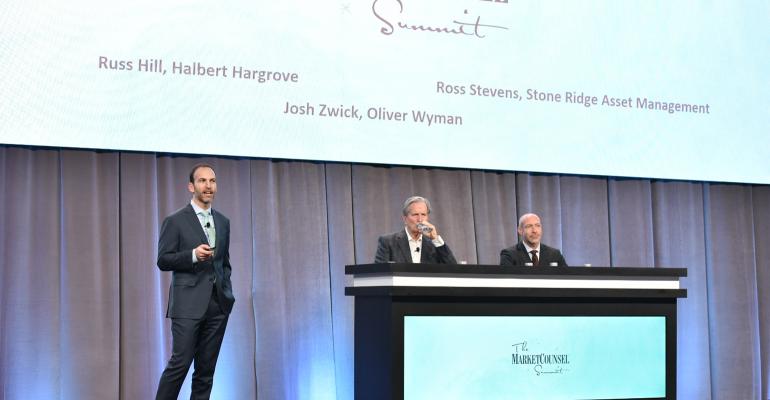The average life expectancy for individuals continues to rise. Great news, but that fuels a retirement savings gap that will reach "disturbing" levels by 2050, said Russell Hill, chairman and CEO of Halbert Hargrove, at the MarketCounsel Summit in Miami this week. Advisors need a strategic plan for helping clients deal with longevity, Hargrove said. And Stone Ridge, a New York-based asset management company, believes it has the answer.
Stone Ridge CEO Ross Stevens said the firm is building a unique solution: A '40 Act mutual fund with a mortality pool wrapped inside. Clients buy into one fund, with a yield that adjusts with age and gender, tracking traditional actuarial tables. It offers monthly liquidity, tax efficiency and principal protection, Stevens said, speaking at MarketCounsel.
“It’s got this critical property that stocks, bonds and all those alternatives don’t have, which is returns that increase reliably as you get older,” he said.
Josh Zwick, partner at Oliver Wyman, said the traditional tools to address longevity aren’t working. With target-date funds, there’s no guaranteed income; there’s equity risk, and low returns with the bond portion of the portfolio. Annuities are hard to access, are pricey and come with a lack of liquidity. Registered investment advisors, he said, don't use annuities because of the stigma around more expensive, less transparent varieties.
What’s needed, Zwick argued, is an investment with a longevity risk premium, where people pay premiums into a pool; the pool pays out to the investors, betting that those who die younger than expected will finance the payouts for those who live longer. We can’t predict the mortality of an individual, but we can predict, with some precision, the mortality of a pool of people, he said.
Stevens said they need at least 250 people to launch the fund; once you get past 250, the precision of the actuarial forecast gets better.
“I could probably tell with a good degree of confidence who is going to die at different ages just with this group in the room,” Zwick said.
Stone Ridge is partnering with the Stanford Center on Longevity, as well as New York Life Insurance Co., which has a 30% market share in income annuities.
“They have the best data, the right data, on how much an 83-year-old female is supposed to earn versus a 65-year-old male, etc. etc.” Stevens said.
Stevens expects the mortality pool to take care of a retiree’s nonnegotiable expenses, along with Social Security.
He contrasted the fund to an insurance product, which guarantees a specific dollar amount payout but is very expensive.
“Instead of having the insurance company backstop that risk, you have all the other shareholders backstop the risk to each other,” which brings down the costs.
The product will only be available for folks ages 65 to 85. By putting it in a '40 Act fund, the cash flows are tax-efficient, Stevens argued, relative to bonds and income annuities. The vast majority of the income is return on capital and not taxed. The extra portion is based on Treasury yields, which aren’t subject to state and local income taxes.
Stone Ridge hasn’t nailed down the price yet, but he said it would be a fraction of insurance brokerage fees.
The product is currently in front of the Securities and Exchange Commission; Stevens said SEC Chair Jay Clayton said the innovation was on par with money market funds and ETFs. He expects the fund to be approved and go live in the third or fourth quarter 2020.





